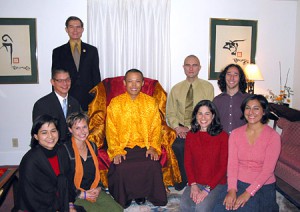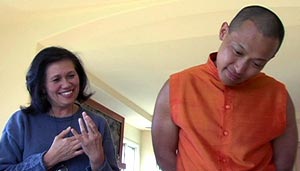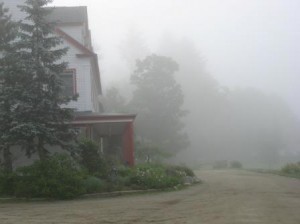Friday
Featured Stories, Sakyong and FamilyTWENTY YEARS OF RULING AND TEACHING: Part Five – Evolution
By Shastri Benoît Côté
When the Sakyong’s second book, Ruling Your World, came out in 2005, few people realized that it signaled a major cultural evolution the Sakyong was finally able to implement in the Shambhala centres all over the world. During this period, a curriculum committee had been set up to propose a new, unified curriculum of study for people entering Shambhala. The Sakyong’s command was very clear. He wanted newcomers to be presented with a series of programs that would introduce the richness of our tradition, showing the relationship between the teaching streams at the basis of the Shambhala lineage. He wanted to move away from putting newcomers into this puzzling choice situation of having to decide whether they were more interested in Buddhism or in Shambhala. On top of that, he asked for “less like school and more like life.”
The resulting curriculum evolved through multiple versions and several pilot experiments. It is still being developed, under the responsibility of Kalapa Acharya Adam Lobel and Executive Director Carolyn Mandelker. The entry program is called “The Way of Shambhala” and brings together weekend programs of Shambhala Training with related classes. The overall idea is to present what comes out as a natural correlation between the four dignities of Shambhala and the three yanas or vehicles of the Buddhist path. The hinayana teachings on karma and samsara are related to the path of tiger. The mahayana teachings on relative and absolute bodhichitta are associated respectively with the paths of lion and garuda. And the vajrayana teachings are obviously at the dragon level. This structure and content in many ways reproduce what is found in the Ruling Your World book.
This change of curriculum was not just a rearrangement of content. It included the introduction of more interactive teaching approaches, in particular the use of dialogue exercises, and encouraged the teachers to work more together. This in turn has lead to a process of revision of how teachers are trained and the creation of a Teacher Academy, under the leadership of Acharya Judith Simmer-Brown, that teachers are expected to participate in on a somewhat regular basis. This lead also to the recent creation of a new category of senior teachers, called shastris, who are associated to a particular center, or region, and have a leadership role in terms of holding the view of the Shambhala Buddhist path and working with the teachers in that respect.
Another aspect of that transformation emerged with the creation of a thangka, or sacred painting, which became available in the fall of 2005. It portrays the Primordial Rigden, a deity representation of the essence of enlightenment according to the Shambhala lineage. It was designed by Sakyong Mipham Rinpoche and executed by the artist Cynthia Moku. That became the main thangka in front of a new Shambhala Buddhist shrine that replaced the two shrines, Buddhist and Shambhala, that most centres had in their main shrine room.
As part of the curriculum development, the Sakyong also committed to teach two programs addressed to beginners, a teaching weekend called “Enlightened World” and a one-week practice retreat called “Sangha Retreat.” The first “Enlightened World” happened at Shambhala Mountain center in August 2007, and the first “Sangha Retreat,” at the same place, in July 2009. The teachings of those two programs were produced as DVD sets by Shambhala Media.
* * * * *
A Vajra Assembly is a particular kind of weekend program that was initiated by the Vidyadhara in 1976. It was restricted to his vajrayana students, people who had done the three-month seminary and received vajrayana transmission from him. From 1976 until 1983, he taught fourteen of them, usually alternating between Boulder and Karmê Chöling. It was an occasion for the vajrayana students to gather, practice and study with the guru. Sakyong Mipham Rinpoche continued this tradition for many years. The last one occurred at Karmê Chöling at the end of September 2005. It was a five-day program in which he taught on the Vidyadhara’s terma.
In July 2006, at Shambhala Mountain Center, Sakyong Mipham Rinpoche started a new kind of post vajrayana seminary program, now a two-week retreat. It was called Shambhala Dzokchen Retreat. Participants were grouped during the day according to their main practice and practiced together lead by an acharya. On particular days or evenings, everybody would get together to receive teachings from the Sakyong.
Between 2006 and 2008, several of these retreats were organized at the major retreat centers: Shambhala Mountain Center, Karmê Chöling, Dechen Chöling and Dorje Denma Ling. Eventually they were called Garchen, meaning “Great Gathering.” The Sakyong was gathering his vajrayana students, both those who had received vajrayana transmission from him and those who had received transmission from the Vidyadhara and wanted to continue studying with him. He started giving more detailed teachings and instructions on Shambhala Vajrayana.
At the last of these gatherings, at Karmê Chöling, in June 2008, Sakyong Mipham Rinpoche made the proclamation that he was now ready to open the Scorpion Seal retreat to all Shambhala warriors having completed the proper preparation. He said:
I have long awaited this time, an appropriate time when we could clarify our unique Shambhala path. I initiated this process with the Primordial Rigden ngöndro and then with the Rigden abhisheka. Now those practitioners who have established a good relationship with the Werma sadhana can enter in stages into the Scorpion Seal.
Those “stages” became a new series of retreats called Scorpion Seal Assembly that started at Karmê Chöling in June 2009. Finally the whole post Vajrayana Seminary path had been clarified. The study and practice of the Shambhala terma received by the Dorje Dradül is at the center of this path. It culminates with the Scorpion Seal retreat. But it can branch out into a whole array of other practices, including the Kagyü ngöndro and the Vajrayogini and Chakrasamvara sadhanas that the Vidyadhara introduced. This is the path of profundity, available to all the students who are inspired by it and willing to exert themselves in that way. This by no way is expected from everybody. Shambhala is basically about vastness, offering a variety of occasions and methods to wake up, to multitudes of beings. But profundity and vastness, or brilliance, have to come together.
* * * * *
In November 2010 the “Letter of the Morning Sun” came out, which represents the most recent letter from the monarch of the kingdom of Shambhala. This is a very personal letter. Writing from his retreat, the Sakyong says:
The purpose of writing this letter is to express some of my inner thoughts, experiences, and intentions to you. After this year of retreat, I wish to have a more open and direct relationship with all of you as Shambhala warriors. Thus far, over the last twenty years as leader of Shambhala, I have refrained from expressing myself as fully as I wished because our community was going through a healing process, as well as a process of maturing. At this point I feel we are all mature enough to take a deep breath and reflect on what Shambhala is, and more importantly, what its future will be.
One can see this letter as some sort of culmination of the last twenty years. It is a powerful letter that offers a fresh formulation of the heart teachings of Shambhala and conveys a sense of urgency. He is now clearly relating profundity with vastness.
First and foremost, Shambhala is based upon a societal vision. Even though it can be seen as a path by which an individual can travel into the great depths of enlightenment, this journey has a greater purpose than that. Shambhala vision is changing the whole social paradigm. For humanity not only to survive, but to flourish and prosper, the whole question and purpose of social existence needs to be addressed. (…)If the Shambhala teachings are to benefit the world, our very own community must now begin to embody these core principles: courageousness, kindness, dependability, skillfulness, and confidence. I am touched as I see that we are beginning to take on some of these traits. (…)
If Shambhala as a vision, a lineage, and a community is to have any real effect on the world, the next ten years are essential. We must now begin to organize, train, and develop ourselves with greater commitment and determination. Therefore, I ask all Shambhalians to see the next ten years as a time to truly challenge ourselves. (…)
The success of our community will depend on what kind of culture we create. In that light, the appeal of Shambhala and our ability to benefit, influence, and inspire the world will come directly from our ability to manifest kindness, embody goodness, and create a genuine feeling of delightfulness. Therefore culture and decorum are essential elements. Ultimately, the greatest influence on us and the larger world is the social culture we are fostering. (…)
The letter goes on describing more precisely what needs to be done. The Sakyong also asks people to contemplate and answer three questions that for him “have been very provocative and illuminating.” He aspires to enter into the next era of Shambhala with “unity, rapport, and clarity.”
A lot has happened in the last twenty years. It certainly looks like there is a lot more to come. I hope that this short and incomplete historical survey will help us see and appreciate the incredible extent and quality of the current sakyong’s activity.
May the Sakyong, Jamgön Mipham Rinpoche live long.
May the lineage initiated by the Great Vidyadhara Chökyi Gyatso flourish for many kalpas.
May all beings feel the warmth of the Great Eastern Sun.
Shastri Benoît Côté
Halifax, 18 February 2011
Note: I would like to thank Richard Reoch, David Brown, and Emily Sell for their comments and encouragement.





















Sep 18, 2011
Reply
Merci cher Benoît pour cette série d’article qui aide à faire se rejoindre anciens et nouveaux étudiants, à replacer les choses dans leur contexte. Très précieux tout ça !
Aug 7, 2011
Reply
Very nice page, I certainly enjoy this website, keep on it, keeping on!
Mar 16, 2011
Reply
This article was good for me because it allowed a glimpse at the history of Shambhala and reminded me of where the future lyes.
Mar 4, 2011
Reply
Thank you, Shastri Cote! These articles have been a real joy to read and will no doubt help further connect new and old to Shambhala and its history. We are all so fortunate to be a part of such a rich lineage led by an amazing teacher!